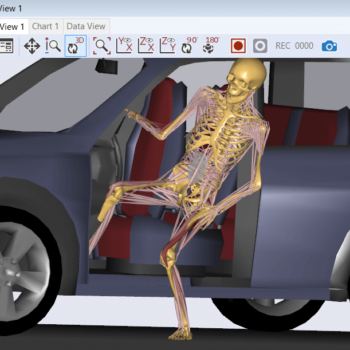The AnyBody Modeling System is a State-of-the-Art musculoskeletal modeling and simulation software for biomechanical analysis. The AnyBody Modeling System allows you to create full body detailed musculoskeletal models and simulate internal body loads as e.g., muscle activity, muscle forces and joint reaction forces.

Features of the AnyBody Modeling System
- Includes the AnyBody Managed Model Repository
- Musculoskeletal analysis of daily activities
- Self-contained and robust system
- GUI for interactive use
- Inverse dynamics
- Inverse-Inverse dynamics
- Force-dependent kinematics
- Posture and motion prediction
- Supports physiological load cases for Finite Element Analysis
- Interface to motion capture systems (C3D and BVH)
- Interfaces to anthropometric databases
- Supports anthropometric model scaling
- Console for batch processing
Why Musculoskeletal Modeling?
Musculoskeletal modeling is a computational way to investigate the mechanical functions of the living body.
Musculoskeletal models output loading in all muscles, joints, and potentially other tissue of the body, as well as potential derived quantities targeting for instance loading of devices, ergonomic analysis, human performance in sports, and the development of cutting-edge designs. Augment laboratory and field studies with biomechanical analyses and use simulation studies as in-silico evidence of the efficacy and safety of your device.
Simulation can make qualified estimation of properties inside the body, which are mostly impossible and unethical to measure – Simulation is the only alternative.
For the exact same reason comprehensive validation can be difficult, but we, together with our many closer users and partners, are striving to provide the best possible verification and validity indicators of our distributed models – see our comprehensive publication list and webcast library.


Benefits of AnyBody simulations
- Virtual prototyping and simulation driven product development
- Shorter time-to-market, reduced research cost and less testing
- Increased product performance and reliability
- Crucial insights into biomechanical parameters of the human body
- New products and devices virtually tested across numerous body sizes and body shapes.
- Better product ergonomics with product design evaluation and optimization
- Ergonomic analyses and documentation
AnyBody Modeling System detailed feature list
- Graphical User Interface (GUI): GUI for interactive use. Read More
- AnyScript: Object-oriented programming language. Read More
- Full-body Human Model: Fully customizable body models which combine for a highly detailed full-body model. Read More
- Modeling of mechanical elements: Simple mechanical systems using segments, joins, drivers, kinematic measures, and forces. Read More
- Muscle modeling: AMS comes with several muscle models; simple, three-element, two-element, and custom user-defined models. Read More
- Muscle calibration routines: Built in system to calibrate muscle tendon/fiber length parameters after anthropometric scaling of the model.
- Embedded Chart View: AMS has an embedded chart view that allows you to review of analysis results e.g., individual muscle activity and joint reaction forces and get a graphical representation of the same.
- Kinematic Analysis: Determines the position, velocity, and acceleration of segments and joints. Read More
- Inverse Dynamics: AMS comes with inbuilt solvers for computing of forces and moments based on kinematics of the human body.
- Inverse-Inverse Dynamics
- Force Dependent Kinematics (FDK): FDK allows the user to alter motion in a joint depending on the acting forces from muscles, ligaments, surfaces, etc. Read More
- Muscle Recruitment Algorithms: AMS allows access to the use of various muscle recruitment algorithms as linear, quadratic, polynomial and max/min muscle recruitment algorithm.
- Interface to marker based optical motion capture systems: Interface to use motion data from marker based optical motion capture systems as e.g., Qualisys or Vicon. Read More
- Interface to IMU motion capture systems: Interface to use motion data from inertial measurement unit motion capture systems as e.g., Xsens. Read More
- AnyBody Exporter for SolidWorks: Add-in enabling users to export CAD models to AMS in the form of editable AnyScript code. Read More
- Support physiological load cases for finite element analysis: Forces and segments from a model in AMS can be exported to provide the boundary conditions of a finite element model. Special interfaces are available for ANSYS and Abaqus.
- Interface to anthropometric databases
- Model scaling: The Human Model is adaptable to sizes and anatomy of various individuals which is useful for product design and to be used for applications, where high geometric accuracy is required, e.g., surface articulations and patient-specific pre-operative planning. Read More
- Ground Reaction Force Prediction: Motion capture data is often recorded without force plates. In traditional inverse dynamics, this would make it impossible to perform a dynamic analysis. However, AMS has the possibility to predict ground reaction forces (GRF), so you can make inverse dynamics models based on recorded motion without GRF force measurement.
- Posture and Motion prediction